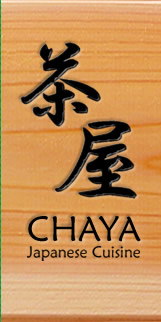Yasu's Ginger Dressing
By Yasu on February 22, 2009 10:35 PM
Ginger dressing is an American influence in Japanese cooking,
because in Japan, people usually eat cooked vegetables rather than
salads. This dressing is quite popular at Chaya, and
many customers ask the chef how to make it.
This recipe is the base for two other salad dressings. Substitute
an equal amount of garlic or wasabi to taste for the ginger. Once you
make the dressing, it can be stored in the refrigerator for as long as
five days. Shake it well before use. Do not use any other brands for the rice
vinegar and soy sauce.
Serve with any salad, particularly with seafood, tofu or soba
noodles. One tasty option is to put the dressing on a salad with cooked
green tea soba noodles, smoked salmon, white onion slices, cucumber and
shrimp.
Yasu's Ginger Dressing
- 3/4 cup Mitsukan rice vinegar
- 3/4 cup Kikkoman or Yamasa soy sauce
- 1 1/2 cups soybean oil
- 1 cup chopped celery
- 1 cup sliced carrots (size of a penny)
- 2 cups chopped white onions
- 1/2 cup sliced peeled fresh ginger
- Fresh lemon juice, to taste (optional)
- Sesame oil, to taste (optional)
Prepare and set out all ingredients. Place them in a blender. Mix on
high speed until the dressing is smooth and creamy. This may take about
40 seconds, depending on the blender's power.
Makes about 1 quart.
(This recipe has been introduced in TRIBUNE-REVIEW.)
Wasabi
By Yasu on February 22, 2009 7:32 PM
Wasabi, a hot green paste made from the roots of a Japanese herb, has a couple of functions.
- Fresh, non-powder wasabi is anti
bacterial. It helps maintaining the freshness of the raw fish.
- It
has nice and light fragrance, which enhances the taste of the fish.
In Chaya, we use the real fresh wasabi, which tastes much different from powder wasabi, or prepared wasabi in tube.
Post-gazette describes our fresh wasabi as follows:
The texture of wasabi, when it's fresh, is less like Play-Doh, more
like food. Organic, I guess you could call it. And while the paste
that's made from the powdered wasabi is content to merely set your
sinuses on fire, fresh wasabi makes its presence known in a subtle,
more flavorful fashion -- clearly worth the extra effort they've
invested in it.
To enjoy the true taste of sushi and sashimi, it is recommended not to dissolve Wasabi into the soy source. Otherwise, it would mute the flavor. If you are not good at wasabi, just tell us so that we can make wasabi-free sushi.
Sushi A to Z
By Yasu on February 22, 2009 5:38 PM
Sushi can be categorized into nigiri (fish-on-top of rice), maki zushi (rolls). Some rolls can further categorized into te-maki (hand rolls) and gunkan maki (seaweed wrapped around rice and fish), typically seen with fish eggs and sea urchi.
Sushi originated as portable meal for the working class people in Japan. It has many styles, all different across Japan. The style that we are familiar with is the Edo style. Edo is the old name for Tokyo, which had abundant fish supply from Tokyo Bay. The Edo style is known for its raw fish material, and the nigiri zushi.








